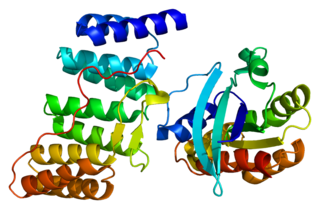
Ras homolog gene family, member B, also known as RHOB, is a protein which in humans is encoded by the RHOB gene.

Insulin-like growth factor-binding protein 4 is a protein that in humans is encoded by the IGFBP4 gene.

Disabled homolog 2 is a protein that in humans is encoded by the DAB2 gene.

UV excision repair protein RAD23 homolog B is a protein that in humans is encoded by the RAD23B gene.

Ras-related C3 botulinum toxin substrate 3 (Rac3) is a G protein that in humans is encoded by the RAC3 gene. It is an important component of intracellular signalling pathways. Rac3 is a member of the Rac subfamily of the Rho family of small G proteins. Members of this superfamily appear to regulate a diverse array of cellular events, including the control of cell growth, cytoskeletal reorganization, and the activation of protein kinases.

Cadherin EGF LAG seven-pass G-type receptor 3 is a protein that in humans is encoded by the CELSR3 gene.

Opsin-3 also known as encephalopsin or panopsin is a protein that, in humans, is encoded by the OPN3 gene. Alternative splicing of this gene results in multiple transcript variants encoding different protein isoforms.

Latrophilin 2 is a protein that in humans is encoded by the ADGRL2 gene.

Zinc-alpha-2-glycoprotein is a protein that in humans is encoded by the AZGP1 gene.

Kallikrein-10 is a protein that in humans is encoded by the KLK10 gene.

Fibroblast growth factor 8 is a protein that in humans is encoded by the FGF8 gene.

Dickkopf-related protein 3 is a protein in the Dickkopf family that in humans is encoded by the DKK3 gene.

Anterior gradient protein 2 homolog (AGR-2), also known as secreted cement gland protein XAG-2 homolog, is a protein that in humans is encoded by the AGR2 gene. Anterior gradient homolog 2 was originally discovered in Xenopus laevis. In Xenopus AGR2 plays a role in cement gland differentiation, but in human cancer cell lines high levels of AGR2 correlate with downregulation of the p53 response, cell migration, and cell transformation. However, there have been other observations that AGR2 can repress growth and proliferation.

60S ribosomal protein L32 is a protein that in humans is encoded by the RPL32 gene.

DnaJ homolog subfamily A member 2 is a protein that in humans is encoded by the DNAJA2 gene.

Interleukin-17 receptor B is a protein that in humans is encoded by the IL17RB gene.

Cytoskeleton-associated protein 5 is a microtubule-associated protein that in humans is encoded by the CKAP5 gene. It is the homolog of the Xenopus protein XMAP215 and is also known as ch-Tog.

Ly6/PLAUR domain-containing protein 3 is a protein that in humans is encoded by the LYPD3 gene.

Histone-lysine N-methyltransferase KMT5B is an enzyme that in humans is encoded by the KMT5B gene. The enzyme along with WHSC1 is responsible for dimethylation of lysine 20 on histone H4 in mouse and humans.

Adenylyl cyclase-associated protein 2 is an enzyme that in humans is encoded by the CAP2 gene.


















